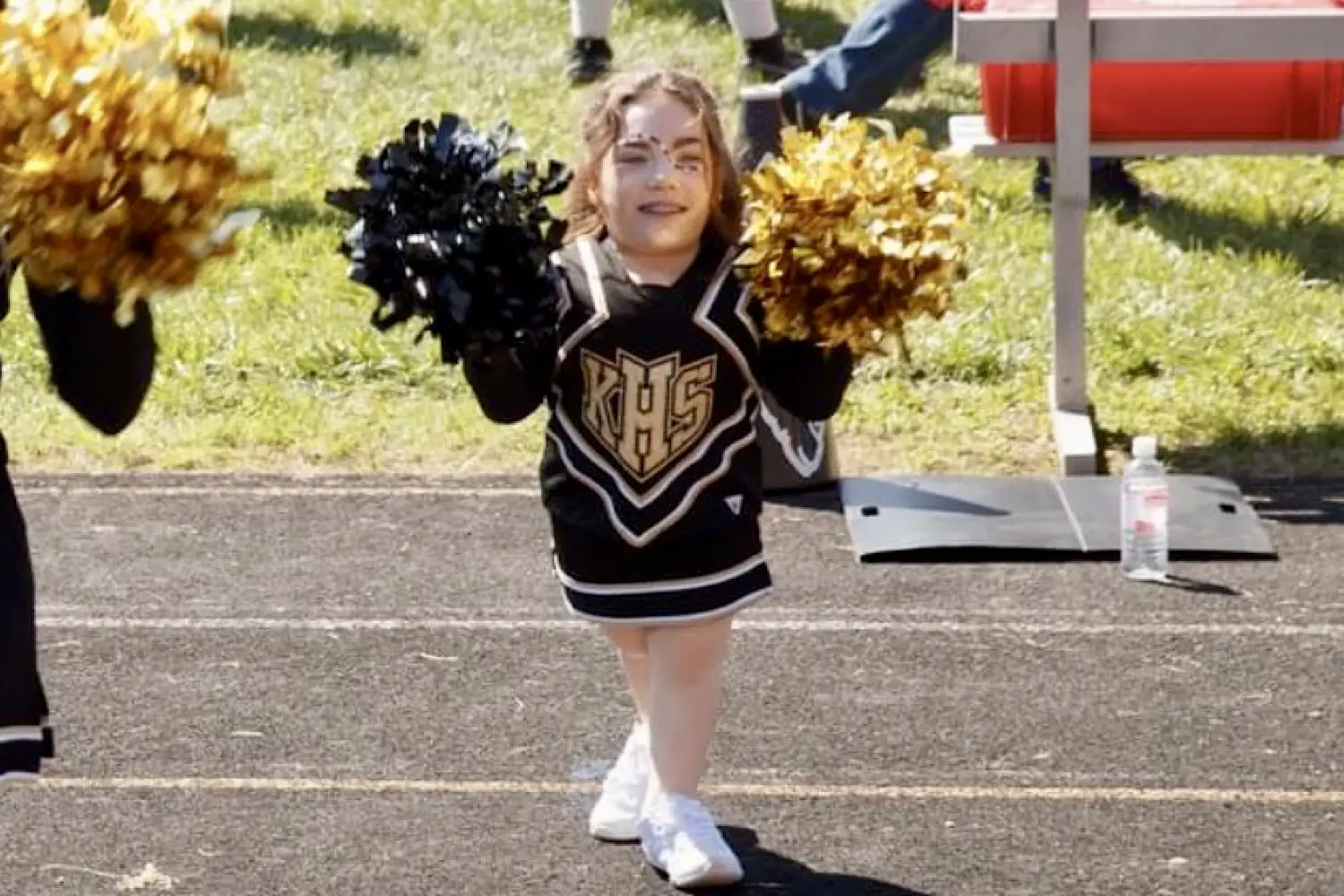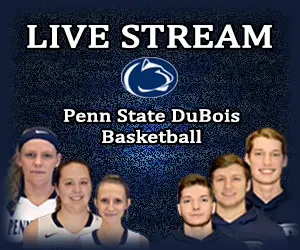
KNOX, Pa. (EYT/D9) — In the third grade, the other children in her class towered over her.
That’s when Chloe Chapman began to realize she was different.
“I was shorter than everyone else,” Chapman said. “A lot shorter.”
The memories of that time are fragmented. Chapman, now a junior at Keystone High School, doesn’t know why she can’t recall portions of her early life.
But now, Chapman is a typical 16-year-old girl.
(Pictured above, Chloe Chapman cheers on the Keystone football team during a game this season/submitted photo)
She plays video games. She hangs out with her friends. She likes to drive around to clear her mind, Taylor Swift playing on the radio.
Chapman is just like any teenager at Keystone — or anywhere else — except she has spondyloepiphyseal dyslplasia.
It’s one of the more than 400 types of dwarfism.
Chapman refuses to let that limit or define her. She is a person, not a label.

Redbank Valley, Keystone, and Union/A-C Valley sports coverage on Explore and D9Sports.com is brought to you by Heeter Lumber.
“The thing I always want to get across is that little people, people with dwarfism, can do the same things as everybody else — we just have to do it differently,” Chapman said. “We can accomplish anything anyone else can do. We definitely push ourselves to show that, I guess. In my personal experience, I like to push myself to show people that little people can do what everyone else can do.”
Including competitive spirit.
Chapman joined the team at Keystone this year. She was a cheerleader for the Panthers as a freshman during football season, but attended an online school for a year before returning to Keystone for her junior year.
At first, Chapman wasn’t sure if she’d join the cheerleading team again. Then, she decided to go for it.
“Cheerleading has always been an interest of mine,” she said. “I did cheer camp when I was in elementary school and I liked it. When I got to high school, I always thought I wanted to do cheerleading, but I didn’t really do it for two years. Then I was like, ‘I want to try it.’ I did and I liked it.”

Chapman wanted to challenge herself.
She wanted to do all the things the other girls on the team could do. She wanted to tumble. She wanted to brace the pyramid. She wanted to be at the top of the pyramid and be part of stunts as a flyer.
She didn’t want her dwarfism to hold her back.
First-year coach Bekah Anderson was unsure.
“I was very delicate about it,” Anderson said. “I sat down with her and asked, ‘Tell me what you can do? Tell me what you want and don’t want to do. Tell me your limits. I won’t question you.’ Kind of like that. She’s been open about everything.”
Chapman said she gained a lot of respect of Anderson for that.
It was exactly the way she wanted to be treated, she said.
“I have no boundaries, but there are things I can’t do,” Chapman said, “She understands that. There are precautions I have to take. I appreciated her laying it out like that for me.”
Chapman was willing to try anything. And Anderson was willing to allow her to do just that.
First, Chapman had to get permission from her doctor, who gave her the green light — with an abundance of caution.
Competitive spirit is not for the timid. There are injuries. Sometimes serious ones. In fact, Keystone had a scare at the end of its performance at the District 9 championships on its home floor when one of its cheerleaders crumpled to the mat with a head and neck injury.
She is OK, but it highlighted just how dangerous the sport can be.
Chapman, though, is never one to shy away from a challenge. She’s always willing to prove what she can do.
“I always attempt to be in that headspace when I go into something, that I’m not going to be afraid to try something new,” Chapman said. “My favorite thing, honestly, is just learning more and getting better at it, like the jumping and just everything. Just becoming a better cheerleader overall.”
Chapman tried to tumble. She found she could. She also found she could do cartwheels. Everything she tried, she was able to do to some degree.
That was a surprise to her and to her coach, as well.
A very pleasant and fulfilling one.
“Originally I wasn’t going to compete. I decided I was going to try and found out I could actually do some stuff,” Chapman said. “I went to practice and was doing everything with my teammates. I asked my coach, ‘Can I try to jump and tumble?’ And she was like, ‘Yeah, go for it.’ And I did and I was like, ‘Wait, I can do it. Why was I saying I couldn’t do that?’
“It felt really good, especially stunting, because that is something that’s obviously a big part of competitive cheerleading,” she added. “When I found out I was able to stunt, I was like, ‘This is awesome!’ The flyer is usually the shortest girl on the team. That’s definitely me. It’s very fun to fly.”
Chapman has also carried an infectious attitude to the team.
Few are as invested in the sport as Chapman. Everything she does on the mat she does with flare, a smile on her face and her enthusiasm filling the gym.
“She is awesome. She’s really impressed me,” Anderson said. “She is probably the most positive girl on the team. She’s never negative. I’ve never heard her say something negative about someone or anything.”

Chapman said she has always been that way. She’s always attempted to put a positive spin on every situation.
There’s always something good that can come out of things, even in something that appears to be overwhelmingly bad.
For her, that means helping the team as much as she can — on the mat and off of it.
“I try my best,” Chapman said. “I like to be the person who if someone doesn’t think they can do it, I’ll say, ‘You can do it. You got this.’ It’s always nice to hear that. I like to hear that, that there’s nothing to worry about.
“I definitely want to challenge myself. Then if I can’t do something, it’s not the end of the world. At least I tried it.”
She has taken that attitude to her interpersonal relationships.
Chapman has always been outgoing.
That personality also lends itself well to being a cheerleader. It’s difficult to find anyone who has as much spirit as Chapman.
“I’ve never had a problem making friends,” she said. “When I got older, it was a little harder, but I’ve had the same friends since I was younger. When I was little, I was really outgoing. I’m an out-there kind of person. Why be shy? I try to be as outgoing as I can around people.”
Chapman has also begun a modeling career. She recently signed with an agency in Alabama and has done several photo shoots.
But her main ambition in life is to become a genetic counselor.
Chapman attends the Little People of America conference each year, where she reunites with all the friends she has made through the organization over the years.
Her best friend lives in Texas. She also has close friends with various forms of dwarfism all over the country in places as far away as Alaska.
“It’s a very good organization,” Chapman said. “It’s one of my favorite things because you get to meet people with dwarfism, and not just my type; all different types. It’s nice because everyone kind of has similar experiences as you and you can talk.
“I remember the first time I went, I felt I fit in,” she added. “I remember I was really sad when I had to leave because I had to go back to where no one was the same height as me. It made me realize there were a lot of people there exactly like me.”
There are an estimated 65,000 people in the United States with one of the various kinds of dwarfism in the United States and more than 650,000 people worldwide.
The only limitations on Chapman come down to her size. She’s an honor student and has lofty goals and dreams.
“There are things I can’t do,” Chapman said. “But there are things that everyone can’t do. The stuff I can do, I’m going to try my best at and make sure I make the most out of them.”
DWARFISM – FACTS AND FICTION
Bodies come in all shapes and sizes. There are about 400 different types of dwarfism. Each type of dwarfism is different than the other. Many types of dwarfism have some medical complications but most people have an average lifespan, being productive members of society. Eighty percent of people with dwarfism have average height parents and siblings. Some types of dwarfism are recessive (that is, carried within your genes even if you don’t know it), but many are simply a genetic change at conception. Dwarfism is usually a simple genetic change, it just happens to have very visible results. A child with dwarfism is born 1 per 10,000 births — that’s 400 births per year in the United States. Very few doctors know very much about dwarfism. It is important to find a doctor who specializes in dwarfism for ongoing care, especially if there are any medical or orthopedic complications. Dwarfism is a condition that affects bones and cartilage. Although there are exceptions, a person with dwarfism’s intelligence and abilities are typical of anyone else.
(source: Little People of America)

Redbank Valley, Keystone, and Union/A-C Valley sports coverage on Explore and D9Sports.com is brought to you by Heeter Lumber.
















